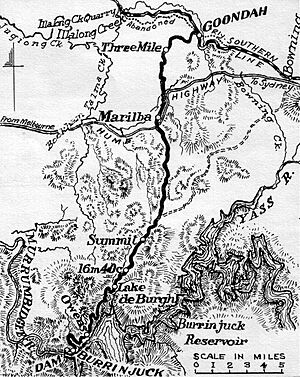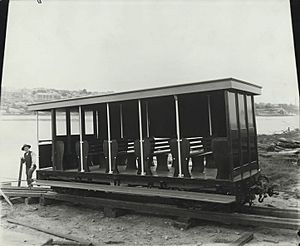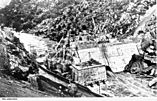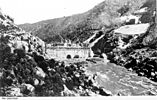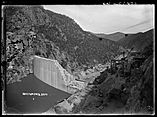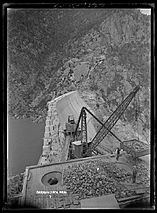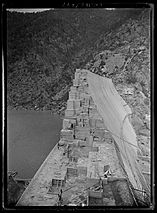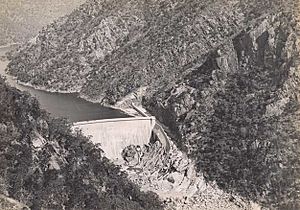Burrinjuck Dam facts for kids
Quick facts for kids Burrinjuck Dam |
|
|---|---|
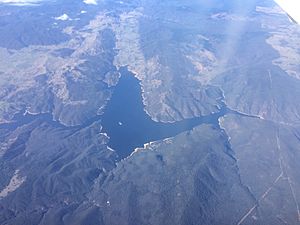
Aerial view of Burrinjuck Dam, 2017
|
|
|
Location of the Burrinjuck Dam
in New South Wales |
|
| Country | Australia |
| Location | Burrinjuck, South West Slopes, New South Wales |
| Coordinates | 34°59′54″S 148°35′04″E / 34.99833°S 148.58444°E |
| Status | Operational |
| Construction began | 1907 |
| Opening date | 1928 |
| Owner(s) | Meridian Energy Australia |
| Dam and spillways | |
| Type of dam | Gravity dam |
| Impounds | Murrumbidgee River |
| Height | 93 m (305 ft) |
| Length | 233 m (764 ft) |
| Dam volume | 394,000 m3 (13,900,000 cu ft) |
| Spillways | 3 |
| Spillway type | Three sector gates with two side channel spillways |
| Spillway capacity | 29,100 m3/s (1,030,000 cu ft/s) |
| Reservoir | |
| Creates | Lake Burrinjuck |
| Total capacity | 1,026 gigalitres (3.62×1010 cu ft) |
| Catchment area | 12,953 km2 (5,001 sq mi) |
| Surface area | 5,500 ha (14,000 acres) |
| Maximum water depth | 72 m (236 ft) |
| Power station | |
| Operator(s) | Snowy Hydro |
| Commission date | 1928 |
| Turbines | 3 (2x6, 1x16) |
| Installed capacity | 28 MW |
| Annual generation | 24.5 gigawatt-hours (88 TJ) |
The Burrinjuck Dam is a huge concrete dam in New South Wales, Australia. It's built across the Murrumbidgee River. This dam is super important for many reasons. It helps control floods, makes electricity, and provides water for farms and towns. The big lake behind the dam is called Lake Burrinjuck.
The dam was built between 1907 and 1928. It's also known by its older names, Barren Jack Dam or Barrenjack. In 2018, a company called Meridian Energy Australia bought the power stations at Burrinjuck Dam. They even plan to make the power station bigger!
The Burrinjuck Dam helps manage water for a large area. It works with other dams like Blowering Dam to make sure farms in the Murrumbidgee Irrigation Area have enough water.
Contents
Building the Dam: A Big Project
Early Ideas
A farmer named Samuel McCaughey owned a lot of land in the Riverina region. He was very interested in saving water. He built his own irrigation channels and pumps to help grow crops. The government liked his ideas so much that they decided to build an even bigger dam.
Starting Construction
Work on the dam began in 1907. Before 1911, the dam was called Barren Jack. To bring building materials to the site, a special narrow railway was built. It was about 45 kilometers long and took over two hours to travel.
Building the dam wasn't easy. There were many delays. In 1911, problems were found in the dam's foundations. World War I also slowed things down. The dam wasn't finished until 1928.
There were also big floods during construction. In 1922, floodwaters reached a record height. They rushed through an unfinished part of the dam. In 1925, another huge flood caused water to flow over the top of the dam wall!
Making the Dam Stronger
In 1937, engineers found that the dam had a weakness. It wasn't a design mistake, but they didn't fully understand all the forces on dams back then. Experts were called in to fix it.
There were even plans ready to evacuate 20,000 people downstream. This was just in case the dam wall ever failed. Luckily, these plans were never needed.
Work to strengthen and enlarge the dam lasted from 1937 to 1957. The dam wall was made taller and stronger. The ways water could flow out (spillways) were also improved. This made the dam safer and able to hold more water.
In 1974, another big flood damaged parts of the dam. This led to a new project to make the dam even safer.
Modern Upgrades
To make the dam super safe, a big upgrade project started. The dam wall was raised by 12 meters (about 39 feet). Special cables were put in to make the dam even more secure during huge floods. These upgrades were finished in 1999 and cost a lot of money.
What is Burrinjuck Dam Like?
The Burrinjuck Dam is located about 60 kilometers (37 miles) from Yass. It's part of a bigger system of dams and controls. This system helps provide water for farms, towns, and industries.
The dam wall is made of concrete with large rocks mixed in. This saved money during construction. The wall is 91 meters (299 feet) high and 233 meters (764 feet) long. When full, the lake behind it holds a massive amount of water. The deepest part of the lake is 61 meters (200 feet).
The dam has three special gates and two side channels. These can release a huge amount of water very quickly.
Making Electricity
Inside the dam, there's a hydroelectric power station. It has three turbines that spin to make electricity. These turbines can generate 28 megawatts of power. This is a fast and clean way to produce electricity!
Weather Around the Dam
The area around Burrinjuck Dam gets a lot of rain, especially in winter. Snow is rare right at the dam. But it snows every year on the nearby hills and mountains. These mountains can be covered in snow during winter.
| Climate data for Burrinjuck Dam (1908–2023, extremes 1965–2023); 390 m AMSL; 35.00° S, 148.60° E | |||||||||||||
|---|---|---|---|---|---|---|---|---|---|---|---|---|---|
| Month | Jan | Feb | Mar | Apr | May | Jun | Jul | Aug | Sep | Oct | Nov | Dec | Year |
| Record high °C (°F) | 45.6 (114.1) |
44.3 (111.7) |
39.0 (102.2) |
34.0 (93.2) |
29.0 (84.2) |
21.5 (70.7) |
20.6 (69.1) |
24.5 (76.1) |
30.0 (86.0) |
34.0 (93.2) |
39.4 (102.9) |
42.1 (107.8) |
45.6 (114.1) |
| Mean daily maximum °C (°F) | 29.8 (85.6) |
29.0 (84.2) |
26.1 (79.0) |
21.1 (70.0) |
16.2 (61.2) |
12.5 (54.5) |
11.7 (53.1) |
13.5 (56.3) |
16.9 (62.4) |
20.5 (68.9) |
24.0 (75.2) |
27.7 (81.9) |
20.7 (69.4) |
| Mean daily minimum °C (°F) | 15.6 (60.1) |
15.7 (60.3) |
13.4 (56.1) |
9.6 (49.3) |
6.4 (43.5) |
4.2 (39.6) |
3.0 (37.4) |
3.7 (38.7) |
5.6 (42.1) |
8.4 (47.1) |
11.1 (52.0) |
13.7 (56.7) |
9.2 (48.6) |
| Record low °C (°F) | 5.9 (42.6) |
7.0 (44.6) |
3.1 (37.6) |
0.9 (33.6) |
−0.7 (30.7) |
−3.8 (25.2) |
−7.0 (19.4) |
−4.0 (24.8) |
−6.1 (21.0) |
0.5 (32.9) |
2.6 (36.7) |
4.7 (40.5) |
−7.0 (19.4) |
| Average precipitation mm (inches) | 63.1 (2.48) |
56.1 (2.21) |
62.5 (2.46) |
64.7 (2.55) |
79.8 (3.14) |
96.0 (3.78) |
100.1 (3.94) |
97.7 (3.85) |
83.4 (3.28) |
85.5 (3.37) |
74.3 (2.93) |
63.1 (2.48) |
926.6 (36.48) |
| Average precipitation days (≥ 0.2 mm) | 6.5 | 5.7 | 6.3 | 6.9 | 9.3 | 12.0 | 13.2 | 13.4 | 10.9 | 10.3 | 8.6 | 7.4 | 110.5 |
| Source: Australian Bureau of Meteorology; Burrinjuck Dam | |||||||||||||
| Climate data for Billapaloola State Forest (1938–1969); 808 m AMSL; 35.27° S, 148.38° E | |||||||||||||
|---|---|---|---|---|---|---|---|---|---|---|---|---|---|
| Month | Jan | Feb | Mar | Apr | May | Jun | Jul | Aug | Sep | Oct | Nov | Dec | Year |
| Mean daily maximum °C (°F) | 26.6 (79.9) |
25.6 (78.1) |
23.1 (73.6) |
17.1 (62.8) |
12.6 (54.7) |
9.3 (48.7) |
8.4 (47.1) |
9.8 (49.6) |
13.8 (56.8) |
16.6 (61.9) |
20.0 (68.0) |
24.3 (75.7) |
17.3 (63.1) |
| Mean daily minimum °C (°F) | 12.1 (53.8) |
11.8 (53.2) |
9.8 (49.6) |
5.8 (42.4) |
3.2 (37.8) |
1.2 (34.2) |
0.1 (32.2) |
0.5 (32.9) |
2.4 (36.3) |
4.8 (40.6) |
7.2 (45.0) |
10.0 (50.0) |
5.7 (42.3) |
| Average precipitation mm (inches) | 86.9 (3.42) |
71.4 (2.81) |
98.8 (3.89) |
113.7 (4.48) |
163.4 (6.43) |
156.1 (6.15) |
172.6 (6.80) |
162.9 (6.41) |
132.6 (5.22) |
145.0 (5.71) |
120.1 (4.73) |
86.5 (3.41) |
1,516.8 (59.72) |
| Average precipitation days (≥ 0.2 mm) | 5.8 | 5.6 | 6.1 | 7.9 | 10.9 | 12.3 | 13.4 | 13.6 | 10.3 | 11.1 | 8.7 | 7.0 | 112.7 |
| Source: Australian Bureau of Meteorology; Billapaloola State Forest | |||||||||||||
Impact on Nature
The water released from the dam is much colder than it would naturally be. This colder water has caused some problems for fish. For example, the Eel-tailed catfish has disappeared from parts of the Murrumbidgee River below the dam.
Why Burrinjuck Dam is Special
The Burrinjuck Dam is a great example of how modern technology helps people. It was the first major dam built in New South Wales just for irrigation. It also helped create the state's first hydroelectric power scheme.
Because of its importance, Burrinjuck Dam is listed on the New South Wales State Heritage Register. It's also recognized as a National Engineering Landmark by Engineers Australia.
See also



